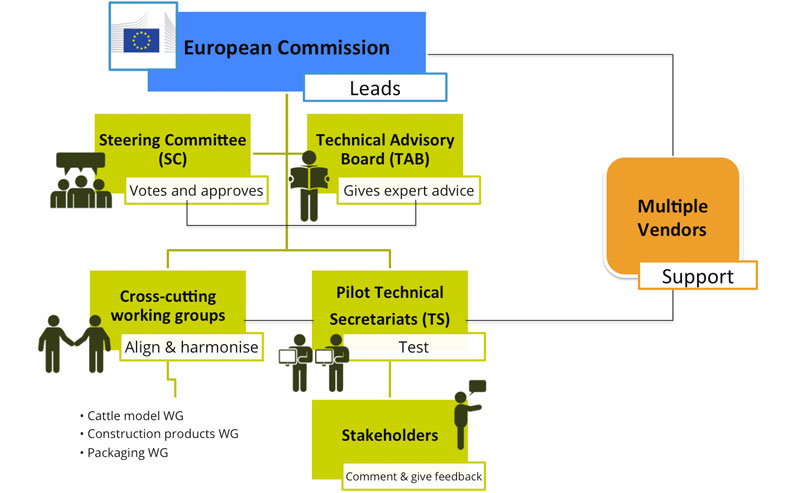Towards environmental footprint rules – PEF governance structure
In the testing of the Environmental Footprint Rules, there are many stakeholders involved. It is a well thought governance structure established for a transparent and collaborative framework. This piece aims at describing the governance structure of the EF rules pilot phase.

European Commission – Leader
The European Commission has an overall lead of the EF pilot phase:
- DG-ENV: coordinates the pilot phase and gives the political direction
- JRC-IES: has the methodological lead and is also coordinating a few pilots
Steering Committee (SC) – Approver
The SC’s main responsibility is the approval of the documents submitted by the pilots, e.g. the draft PEFCR/OEFSR. The SC is constituted by one member of each pilot, representatives of the EC, one representative from each EU member state, EFTA, or candidate country, and one representative from key stakeholder groups (consumers, SMEs, environmental NGOs, business and international organizations).
Technical Advisory Board (TAB) – Expert Advisor
The Techincal Advisory Board provides technical support and advice to the SC members that have appointed them. Each member of the SC may appoint 1 expert to be a member of the Technical Advisory Board. The TAB expresses its opinion and input to the Commission on technical issues that are of cross-cutting relevance to several EF pilots.
The detailed rules of procedure applied to EF Pilot SC and TAB can be consulted here.
Pilot Technical Secretariats (TS) – Testers
There are 26 active pilots that have volunteered to test the development of the rules and to develop PEFCRs (24) – e.g. dairy products, and OEFSRs (2), e.g. retail. Each pilot TS has one coordinator, meaning that this person is the contact person for the pilot, and various members, which can be manufacturing companies, other actors in the product/sector value chain, NGOs, etc. Most TSs (73%) cover more than 50% of the EU market.
Stakeholders – Feedback Providers
There are fixed moments in which documents, e.g. draft PEFCR/OEFSR, are released for stakeholder consultation. Anyone can register as a stakeholder and submit comments during the period indicated on the wiki of the EF pilot phase. The pilots need to consider these comments and provide an answer as to how these will be tackled. For the final round of consultations (expected between June and September 2016), the documents will be published on the website of DG-ENV as well.
Cross-cutting Working Groups – Harmonization
There is a number of cross-cutting working groups established in the pilot phase which aim(ed) at creating horizontal rules for issues that are common to several pilots. These working groups (WG) are:
- Cattle Model WG: to ensure consistency in modelling the cow as a common element between dairy, meat, leather, feed and pet food pilots, e.g. to define the multi-functionality rules at farm and at slaughterhouse level. This activity is complete and the final result is available on the wiki.
- Construction products WG: to contribute to better understanding the differences between the requirements of EN15804 and the PEF method, paving the way reconcile current differences in the next revision of both documents.
- Packaging WG: to provide guidance on packaging related modelling and data issues in the Environmental Footprint pilot phase. Last meeting planned for 12 May 2016.
Multiple Vendors – Support Providers
The Commission is contracting, through calls for tenders, vendors to support activities related to the EF pilot phase. Examples include, e.g. the Technical Helpdesk (of which PRé is one of the partners), Support of the communication testing, Development of SME tools, etc.
The Big Question Is…
What will be the governance structure of Environmental Footprinting after the pilot phase? Of course, the governance structure will most likely change after the pilot phase. How it will change depends on the coming developments, so time will tell… I guess we’ll just have to be patient to know the answer. Lastly, in this piece, I limited my description to the governance structure and stakeholders. The development rules will be illustrated in a coming piece. Stay tuned!
Learn more about PEF
If you want to learn more about our role in the PEF initiative, please contact us. See other episodes of this series:
- PEF: A game changer in LCA
- PEF: End-of-life modeling
- PEF: The role of the representative product
- PEF: Hotspot analysis
- PEF: Data requirements
- PEF: Governance structure
- PEF: Impact assessment
- PEF: Carbon modeling
- PEF: Environmental footprint of organizations
- PEF: Guidance for modeling the use stage
- PEF: Energy and transport data
- PEF: State of the debate and outlook
- PEF: The end of the pilor phase
- EF: Transition phase
Marisa Vieira
Director of Solutions
The time of the industrial revolution is over. Now it is time for the green revolution to go full steam ahead! Everybody needs to be involved in this process, therefore I aim to guide individuals and businesses in understanding the trade-offs between impacts. This will help them make informed decisions, which will truly help sustainable living thrive."